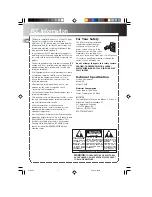
Safety Instructions, Warnings, and Notes
2.
2.
Safety Instructions, Warnings, and Notes
Index of this chapter:
2.1 Safety Instructions
2.2 Maintenance Instructions
2.3 Warnings
2.4 Notes
2.1
Safety Instructions
Safety regulations require the following
during
a repair:
•
Connect the set to the Mains/AC Power via an isolation
transformer (> 800 VA).
•
Replace safety components, indicated by the symbol
h
,
only by components identical to the original ones. Any
other component substitution (other than original type) may
increase risk of fire or electrical shock hazard.
•
Wear safety goggles when you replace the CRT.
Safety regulations require that
after
a repair, the set must be
returned in its original condition. Pay in particular attention to
the following points:
•
General repair instruction: as a strict precaution, we advise
you to re-solder the solder connections through which the
horizontal deflection current flows. In particular this is valid
for the:
1.
Pins of the line output transformer (LOT).
2.
Fly-back capacitor(s).
3.
S-correction capacitor(s).
4.
Line output transistor.
5.
Pins of the connector with wires to the deflection coil.
6.
Other components through which the deflection current
flows.
Note:
This re-soldering is advised to prevent bad connections
due to metal fatigue in solder connections, and is therefore only
necessary for television sets more than two years old.
•
Route the wire trees and EHT cable correctly and secure
them with the mounted cable clamps.
•
Check the insulation of the Mains/AC Power lead for
external damage.
•
Check the strain relief of the Mains/AC Power cord for
proper function, to prevent the cord from touching the CRT,
hot components, or heat sinks.
•
Check the electrical DC resistance between the Mains/AC
Power plug and the secondary side (only for sets that have
a Mains/AC Power isolated power supply):
1.
Unplug the Mains/AC Power cord and connect a wire
between the two pins of the Mains/AC Power plug.
2.
Set the Mains/AC Power switch to the "on" position
(keep the Mains/AC Power cord unplugged!).
3.
Measure the resistance value between the pins of the
Mains/AC Power plug and the metal shielding of the
tuner or the aerial connection on the set. The reading
should be between 4.5 Mohm and 12 Mohm.
4.
Switch "off" the set, and remove the wire between the
two pins of the Mains/AC Power plug.
•
Check the cabinet for defects, to prevent touching of any
inner parts by the customer.
2.2
Maintenance Instructions
We recommend a maintenance inspection carried out by
qualified service personnel. The interval depends on the usage
conditions:
•
When a customer uses the set under normal
circumstances, for example in a living room, the
recommended interval is three to five years.
•
When a customer uses the set in an environment with
higher dust, grease, or moisture levels, for example in a
kitchen, the recommended interval is one year.
•
The maintenance inspection includes the following actions:
1.
Perform the “general repair instruction” noted above.
2.
Clean the power supply and deflection circuitry on the
chassis.
3.
Clean the picture tube panel and the neck of the picture
tube.
2.3
Warnings
•
In order to prevent damage to ICs and transistors, avoid all
high voltage flashovers. In order to prevent damage to the
picture tube, use the method shown in figure “Discharge
picture tube”, to discharge the picture tube. Use a high
voltage probe and a multi-meter (position V
DC
). Discharge
until the meter reading is 0 V (after approx. 30 s).
Figure 2-1 Discharge picture tube
•
All ICs and many other semiconductors are susceptible to
electrostatic discharges (ESD
w
). Careless handling
during repair can reduce life drastically. Make sure that,
during repair, you are connected with the same potential as
the mass of the set by a wristband with resistance. Keep
components and tools also at this same potential. Available
ESD protection equipment:
–
Complete kit ESD3 (small tablemat, wristband,
connection box, extension cable and earth cable)
4822 310 10671.
–
Wristband tester 4822 344 13999.
•
Be careful during measurements in the high voltage
section.
•
Never replace modules or other components while the unit
is switched "on".
•
When you align the set, use plastic rather than metal tools.
This will prevent any short circuits and prevents circuits
from becoming unstable.
2.4
Notes
2.4.1
General
•
Measure the voltages and waveforms with regard to the
chassis (= tuner) ground (
H
), or hot ground (
I
), depending
on the tested area of circuitry. The voltages and waveforms
shown in the diagrams are indicative. Measure them in the
Service Default Mode (see chapter 5) with a colour bar
signal and stereo sound (L: 3 kHz, R: 1 kHz unless stated
otherwise) and picture carrier at 475.25 MHz for PAL, or
61.25 MHz for NTSC (channel 3).
•
Where necessary, measure the waveforms and voltages
with (
D
) and without (
E
) aerial signal. Measure the
voltages in the power supply section both in normal
operation (
G
) and in stand-by (
F
). These values are
indicated by means of the appropriate symbols.
•
The semiconductors indicated in the circuit diagram and in
the parts lists, are interchangeable per position with the
semiconductors in the unit, irrespective of the type
indication on these semiconductors.
•
Manufactured under license from Dolby Laboratories.
“Dolby”, “Pro Logic” and the “double-D symbol”, are
trademarks of Dolby Laboratories.
V
E_06532_007.eps
250304





































